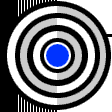| November 16, 2001 |
|
 |
 |
|
A new way to make "neuts" Paul Preuss, paul_preuss@lbl.gov |
||
|
|
Neutrons can penetrate deeply to find defects
in large machine parts or tiny microdevices, elucidate the structure of
biological systems and polymers, sense fluids in geological formations,
and probe solids and liquids on the atomic scale.
Recently Ka-Ngo Leung and his colleagues in Berkeley Lab's Accelerator and Fusion Research Division (AFRD) have devised a series of neutron generators small enough to descend into a borehole, provide neutrons for brain-cancer therapy, peer inside airport luggage, or perch on a laboratory bench.
Leung is head of the Plasma and Ion Source Technology Group in AFRD's Ion Beam Technology Program. In many ways the performance of the group's compact generator matches the largest neutron sources now in use — at a fraction of the cost. For this reason, says William Barletta, AFRD division director, "neutron tubes offer a means of providing a new generation of instruments on university campuses to provide a growing, vigorous user base for national user facilities." Freeing the neuts Although isotopic sources release small amounts of neutrons by radioactive decay, many research programs rely on fission reactors or on high-energy particle accelerators like Los Alamos's LANSCE, which uses proton beams to break up heavy nuclei in a target. These large installations yield copious amounts of neutrons at energies up to hundreds of millions of electron volts. Neutrons are also freed in fusion reactions. Commercial "neutron tubes," only a few inches long, are miniature, low-energy accelerators that produce neutrons by hitting a metal target with deuterium or tritium ions. The fusion reaction occurs between the deuterium in the beam and deuterium or tritium in the target (D-D or D-T reactions). Commercial tubes, including electronics, typically cost $100,000; they cease to function once their target is depleted of hydrogen isotopes. "Our interest in neutron generators began about five years ago, when we worked with the Earth Sciences and Engineering divisions to build a downhole logging device," says Leung. To help study the geology of Yucca Mountain, the researchers developed an efficient device that increased neutron output over commercial sources hundreds of times, but still fit inside a two-inch borehole. Driven by a radio-frequency antenna, the miniaturized plasma source produces a high current of deuterium ions, more than 90 percent of them single atoms, much more likely to produce neutrons in the target than two- or three-atom molecules. Beams in commercial sources are typically only 20 percent monoatomic. Ions on target "After we made the logging device, we asked ourselves if a larger tube could be made for boron neutron capture therapy, BNCT," says Leung. BNCT is an experimental treatment for an inoperable form of brain cancer that uses energetic neutrons from reactors or accelerators, but Leung's calculations indicated that with a D-T reaction, a compact neutron generator could produce the needed amount of neutrons at the right energy, around 10,000 electron volts. The new design included a new kind of target containing no hydrogen isotopes. All the deuterium/tritium comes from the beam itself, hitting a thin layer of titanium bonded to a layer of copper that is pierced with water-cooling channels. Since the deuterium/ tritium is continually loaded onto the titanium, the target cannot be depleted. To get sufficient flux for BNCT, Leung says, "we needed D-T reactions, which are more efficient in neutron production than D-D. But the great majority of research programs and applications want much lower energies — so-called 'thermal' neutrons that are easily produced by D-D. One advantage is that deuterium is stable." Leung's group found an elegant way to multiply the neutron output of a compact source. Instead of a generator shaped like a TV picture tube — with a single beam of ions from a plug-shaped source striking a target plate — they built a coaxial cylinder, in which a rod-shaped ion source emits beams radially along its length, striking a large target wrapped around it. "The beauty of the coaxial design is that you can easily increase production by lengthening the cylinders," Leung says. "You can also nest ion sources and targets inside one another." The result: tens of trillions of neutrons per second. Next page: Sculpting the Pulse, Shaping the Energy |